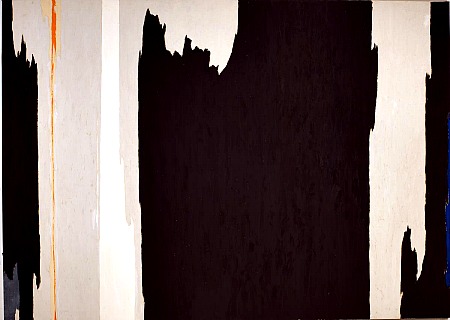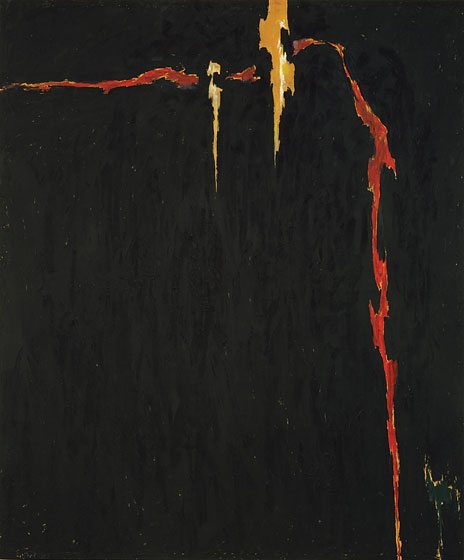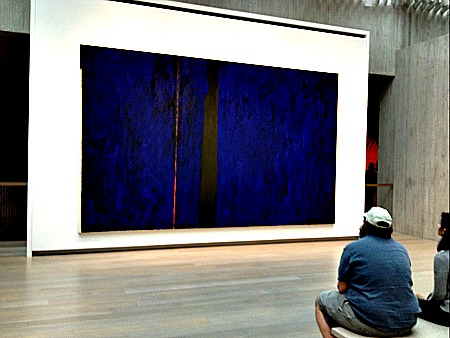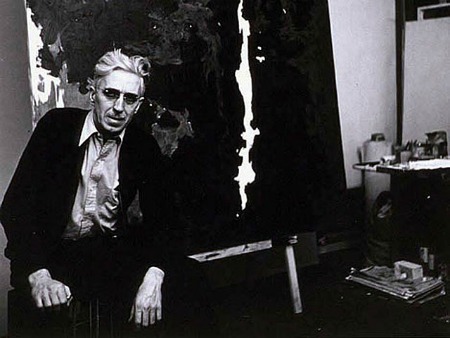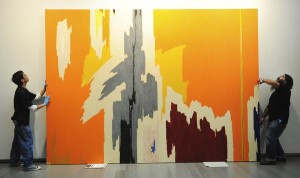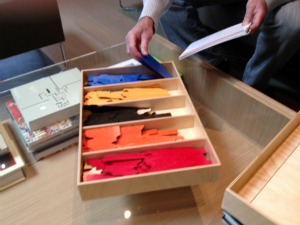Way Out West…
Since I was in the Denver area, I decided I just had to see the Clyfford Still Museum that opened late last year. Mark Van Wagner and I finished the installation of our travelling show, “Drawing from Sand,” in one day flat, so there was some breathing room. I call it “a small show with a global impact.”
Van Wagner and I met through Facebook because we both use sand. One thing led to another, and although we never spoke to each other, 100 emails later our joint show opened in the Kauai Museum in Hawaii, and thence to Boulder, Colorado (after that to Bellport, N.Y.).
My fear of being pelted by stones thrown by hippies in tie-dye outfits because I was wearing New York black was groundless. Boulder is fine. Naropa University, site of our show, is very Buddhist, very cool. Although the student garb is far to colorful for my taste.
Now, of course, I have to figure out what to do about Clyfford Still.
Still’s one-artist museum is right next to Daniel Libeskind’s “cutting edge” Denver Museum of Art, which is right next to Ponti and Sudler’s PoMo building, itself once called cutting edge. Will the DMA keep adding buildings every time there’s a new architectural fad?
In contrast, the Clyfford Still Museum is sedate. The art is not, nor was the man.
Still claimed to be the first Abstract-Expressionist and would allow no contenders.
Although he showed with the Betty Parsons Gallery — along with Jackson Pollock, Mark Rothko, and Barnett Newman — he reserved all laurels for himself and was quite cranky about it. Furthermore, he did not countenance unapproved interpretations of his art and worked himself into a snit. My Uncle Barney had obviously stolen the zip from him. But “Big Blue,” now on display is dated 1951 and Newman’s Onement is 1948. Who stole what from whom? More research is needed.
And Still’s old friend Mark Rothko had gone commercial. In fact, Still blustered and fumed and withdrew from the art world and would not let anyone buy or see his paintings. Later he apparently gloated over Rothko’s suicide, but he did not see a contradiction when he was lured by the deep pockets of the Marlborough Gallery. If that is not going commercial, I don’t know what is.
Still held back over 800 of his artworks, which seems to be about 80%. And willed the lot to whatever city would put up the cash for a Clyfford Still Museum. It could not show the work of any other artist, because he was beyond compare. Nor could there be an auditorium or a restaurant.
Was Still crazy? Or just crazy like a fox?
The first floor of the one-man museum is devoted to educational displays — including a rather paranoid letter to critic Clement Greenberg and an equally mad letter to Betty Parsons that announced his withdrawal from the evil art world — the same art world that is still with us. If you want further evidence of Still’s hubris see Tyler Green’s three-part story. Click here.
And Green actually likes Still’s paintings!
Here is a link to Mr. Still’s letter to Greenberg.
The more I know about Still the less I like him. He was, according to Green, a McCarthyite, and he called the Museum of Modern Art in New York the “Great Gas Chamber of culture.” Perhaps he had heard that Philip Johnson, who co-founded the Department of Architecture, had been pro-Hitler in the Thirties. Maybe, but I doubt it. When MoMA wanted a painting he pawned off what he thought of as an inferior copy he made just for them.
Should he go to the head of the Ab-Ex pantheon? Or was his boast much bigger than his light? Now, at last, we can see for ourselves, but I think it will take awhile to digest such gnarly, willfully difficult paintings. And the man sure was full of himself.
On the second floor of the Still Museum is a chronological installation, beautifully displayed in a succession of well-proportioned rooms. In contrast to the externally ultra-photogenic Libeskind next door, there is not one obtuse or acute wall in the whole museum; there is not one dead space or “spear closet.”
The early work offers the same old story. Provincial paintings, WPA, and then the breakthrough moment: a vertical, crooked streak of red on a stygian plane, supposedly made in 1944. This is followed by a fully fleshed-out survey of the Stills that really look like Stills — mostly big bruisers with inflections that make many think of shredded wallpaper or birch bark or peeling billboards. Gloom provides the continuity with his WPA work. And doom haunts every abstraction, save for the requisite opening up to joy that we now seem to expect of old men.
Matisse was the forerunner of this “late works” phenomena; and then de Kooning. There’s a “late works” trope in classical music that tortures musicologists. One could characterize the “late works” trope in art as simplicity and light , whereas in music it is characterized by the depths of Beethoven’s last string quartets, or Richard Strauss’ Metamorphosis —- rather than Schoenberg’s turn to tonality, which confuses everything. Maybe Schoenberg was really a painter.
“My work in its entirety is like a symphony in which each painting has a part,” Still wrote. If this is the case, then his last movement is a kind of triumph of talent over a pompous, paranoid personality. And thus so is the entirety. Gestures in a void. A bit like a few corn flakes in an empty bowl.
And then a triumph?
As much as Rothko and Newman, Still came up with a signature style. But perhaps we could say a language rather than a style. A style is too easily reinterpreted as a brand. That is not quite how art works. You need style plus spirituality. And you need biography. Unfortunately the Still biography stinks. The back story is loathsome.
Can we really separate the man from the art? If knowledge of Matisse’s passivity, if not quite outright collaboration, under Vichy, has soured me on his late work, then how can I look with favor upon the work of a right-wing crank like Still?
Still is being pitched to the Denver locals as a maverick. Was he? He seems to have had too many teaching jobs to be a maverick. Nevertheless, when you stand in front of his paintings, you get the picture; you get grandeur. Or is it a full dose of the grandiose?
More than anyone else, except de Kooning, Still privileged tactility. The paint application, usually in large vertical “shreds”, brings you back to the surface of the canvas and ruptures the light. There’s a struggle akin to de Kooning’s gnostic fraktur, but unlike de Kooning, the war is not made tolerable by insouciance or wit.
Just as with de Kooning, you wonder when Still knew a painting was finished. Are the paintings finished? Some of them are scary. They are not paintings that can kill, as he claimed; but they are not to die for. Perhaps like de Kooning, Still just walked away. Paintings are not made; they are abandoned. If this is the case, that moment of turning his back is Still’s true act of creation. If he was the first abstract expressionist then his work is the synthesis of his successors. So what stood in his way? He didn’t get along with anybody. He was a grouch. And an egomaniac. And he was the only artist in the world.
Clyfford Still is a bad influence.
The John Perreault Museum
Now, as an artist, I am no longer merely content to demand a retrospective at MoMA or the Whitney. The stakes are higher. I want my own museum. But, like Still in his will, I have stipulations. Not just any city will qualify. After all, what did Still have to do with Denver? Nothing.
The place that wins the honor of hosting the John Perreault Museum, unlike the Still Museum, must have something to do with the life of the real John Perreault. Clyfford may have passed through Denver a couple of times, taught at the then far-distant Boulder for one meager semester, but he had as much to do with Denver as he had to do with Oshkosh or Sheboygan. The City of Denver put up the cash.
The John Perreault Museum must be in New York City, where I was born, preferably in the East Village where I have lived so long.
The John Perreault Museum must continually have all my unsold artworks on display and they should always be in the majority. Otherwise, the museum may show examples of work by any artist I have written about as an art critic, even artists I have attacked.
Unlike the Clyfford Still Museum, no part of the John Perreault Museum may be rented out for events of any kind. Strollers will be forbidden, as well as humans under 16. As at the Still, photography will be allowed, but even with flash. And pencils and pens, if used to take notes, will also be permitted, unlike in the Museo del Barrio and the New Museum in NYC. Snapshots and note-taking spread the word.
Clearly the John Perreault Museum will be even stricter than The Still. Like at The Still, no auditorium or restaurant, please. Absolutely no gift shop; absolutely no Perreault jigsaw puzzles. No dance or music concerts anywhere in the Perreault Museum. No docents, gallery lectures. No loud talking. Only whispers. No poetry readings except of poems by Perreault.
Sumptuary laws will apply.
All clothing worn by visitors must be black. Perfume is forbidden. As are cowboy boots with or without taps and click-clack high-heeled shoes of any sort. No one must be taller than my art. Jewelry will be confiscated, especially jewelry that jingles and jangles, including the 14 k. gold watch bracelets worn by very rich lawyers and accountants.
No starch, no pudding. And above all, no art criticism.
____________________________________________________
To sample John Perreault’s sand paintings you may preview online the Kauai Museum/Naropa University catalog for Mark Van Wagner and John Perreault: Drawing from Sand, with a short essay by art critic Peter Frank. Click Here. The exhibition ran from Nov. 12 to Jan. 20 in Lihue, HI. And is now at the Lincoln Gallery, Naropa University, Boulder, CO., until May 15; thence to Gallery 125, Bellport, N.Y., from June 23 to July 15.
For easy access to 200 previous Artopia essays by topics, go to top bar, click on ABOUT, click on ARCHIVE, then scroll down to listing by Headlines.
NEVER MISS AN ARTOPIA ESSAY AGAIN! FOR AN AUTOMATIC ARTOPIA ALERT contact perreault@aol.com
John Perreault is on Facebook and now on Tumblr. You can also follow John Perreault on Twitter: johnperreault
For Art Cops cartoons and other videos on Youtube: John Perreault Channel.
Main John Perreault website. More of John Perreault’s art.

